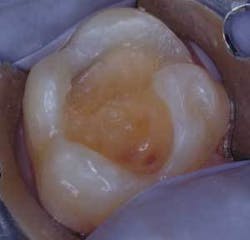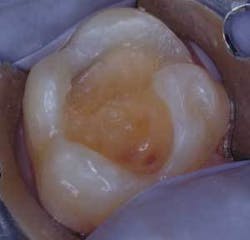Mandatory adhesive principles
A solid grasp of the principles and mechanics of bonding and adhesive systems is essential to the practice of restorative dentistry. In this article, I review the adhesive systems currently on the market, consider their pros and cons, and suggest strategies for optimizing restorative outcomes.
Bonding is the common link in all contemporary dentistry. Universally, with direct as well as indirect restorations, bonding is the intermediate link bridging sound tooth structure and the restorative material. Modern bonding techniques should be understood as a process, not just an outcome. In 1980, Nakabayashi and colleagues developed the modern concepts of dentin bonding. These principles for dentin bonding are based on the development of a hybrid layer. Initially, by removal of the surface smear layer created by rotary instrumentation, acid enters exposed dentinal tubules and diffuses to a depth, which is time dependent. The acid penetrates peritubular dentin, removing hydroxyapatite and leaving exposed collagenous fibers. Resin infiltrates spaces previously occupied by the hydroxyapatite. This interdiffusion layer, or hybrid layer, once polymerized closely resembles a natural dentinoenamel junction, or DEJ. Modern dentin-bonding adhesives allow for adhesive restorations to be placed with a high degree of predictable clinical success.
Adhesive systems defined
At last count, there are currently 46 adhesive resin systems available to the dental clinician. All these adhesive systems are typically categorized into fourth, fifth, and sixth generation products. This I believe is an over-simplification that requires further definition.
A fourth-generation system (three-step total-etch) has its components of etchant (phosphoric acid), primer, and bonding resin packaged separately and applied sequentially. Developed in the late 1980s, these multiple-component total-etch adhesive systems are still the standard by which more recently developed adhesive systems are judged. When comparing the physical characteristics of bond strength to dentin/enamel and microleakage, none of the newer adhesives perform better than the original multiple-component total-etch systems.
A fifth-generation system (two-step total-etch) is a double-phase product, which has its primer and bonding resin packaged together and applied as one component. In the initial step, phosphoric acid is still used to demineralize the enamel and dentin surfaces. This simplifies the bonding protocol by one step. It was developed to meet the clinicians’ desires for a quicker, easier, and less technique-sensitive bonding system. Unfortunately, the bond strength is dependent on the hydration of dentin. The two-step total-etch system becomes more technique-sensitive than the three-step total-etch system, because of the subjective, if not ambiguous, nature of the “wet bonding” technique. Also, without the use of a separate activator, most two-step total etch systems do not bond well to self- and dual-cure composites.
A sixth-generation system usually implies a self-etch adhesive system that incorporates the phosphoric esters into the primer component. This category of adhesive systems can be divided into two distinct sub-groups: 1) two-component self-etch systems, and 2) single-component self-etch products. The two-component (primer and bonding resin are packaged separately) self-etch system’s physical properties, especially bond strength, are dependent on the ability to mix the A and B components completely. The advent of self-etch adhesives is a true evolution toward faster, easier, and less technique-sensitive bonding protocols. The primary advantage of the self-etch systems is that they do not depend on the hydration of the prepared dentin. Because of their ease of use and the reported low occurrence of postoperative sensitivity, this category recently has been gaining popularity. Despite their popularity, there should be universal agreement that self-etch systems do not bond as effectively to enamel as the total-etch systems. In fact, some manufacturers state clearly in their enclosed directions that the product does not bond adequately to uncut enamel. Clinically-based research has shown the bond to acid-etched enamel from a total-etch system to be reliable and predictable. It also has been found that long-term bonding to dentin is less predictable and possibly much shorter-lived, regardless of the adhesive system used. The highly acidulated hydrophilic groups that facilitate initial resin-collagen hybridization seem to be the primary cause of the long-term degradation of bond strength. This appears to be especially true of the sixth-generation self-etch systems.
Keys for success
There are a few basic principles to be respected during the clinical procedure of dentin resin hybridization (bonding). These essential elements are primarily related to issues of dentin contamination and, secondarily, the susceptibility of the collagen hybrid layer to collapse before polymerization. Common contaminates which may inhibit adequate bonding include saliva, blood, sulcular fluids, residual smear layer, and hemostatic agents. The solution relies much on appropriate isolation through retraction, suction, and use of a rubber dam. If desiccated, dentinal collagen fibers collapse onto themselves and adequate bonding cannot take place. Without complete resin incorporation, the adhesive bond results in a weakened dentinal matrix prone to staining, bacterial invasion, and reduced bond strength.
There are three fundamental keys for successful bonding -
First, follow the manufacturer’s suggested protocol. Do not assume that there is one universal technique for all adhesive systems. Do not just listen to manufacturers’ representatives or podium speakers, but read the printed technique sheets packaged with your specific system.
Second, know if the bonding agent is a filled or unfilled resin. This will affect the degree of required agitation during conditioning, as well as viscosity and flow properties during air-thinning or solvent volitization. During storage, filler particles of a filled adhesive may settle to the bottom of the container. To achieve optimal physical properties, vigorous agitation may be required before use. Filled adhesives appear to be less technique-sensitive and may provide a more uniform cured film resulting in higher bond strengths and less postoperative sensitivity.
Third, know what solvent is used in your adhesive system. Acetone is the most volatile solvent and the most susceptible to desiccation. Ethanol-based adhesives, also quite volatile, could benefit from a blot technique for thinning. Water-based adhesives are the least susceptible to volatilization. With these adhesives, a robust and steady stream of air would be more advantageous to thin the solvent.
With all adhesives systems, bond strengths decrease as the shelf life matures. This change in physical properties arises from the degree of volatilized solvent during repeated use. Thus, adhesives should only be dispensed just prior to their intended use. Single-use delivery systems eliminate the concern of shelf life and volatilization prior to use.
Direct restorative considerations
Knowing the types of adhesive systems available and their strengths and weaknesses, the issue for practitioners becomes how best to apply these bonding systems in the art and science of restorative dentistry.
Direct composite materials require special considerations because of their potential for volumetric shrinkage during polymerization. This can place stress on the adhesive layer as well as adjacent tooth structure. A more “bulk fill” approach can result in the resin adhesive layer tearing from dentin and the premature degradation of the hybrid layer. This can result in an incomplete bond, which can ultimately contribute to postoperative sensitivity. Layering small increments of 2 mm or less can minimize shrinkage and consequently decrease physical stress on the interdiffusion layer.
Indirect restorative considerations
Conventional restorative dentistry was based on the time-honored principles of G.V. Black. Modern dentin bonding principles allow for a paradigm shift to a less invasive restorative approach. It should be universally accepted that most of G.V. Black’s doctrine is no longer applicable to contemporary adhesive dentistry.
Complete excavation of pathologic tooth structure reveals minimal and unsupported tooth structure with a vital pulp exposure.
While my practice has matured, the evolution of adhesive dentistry in the last 16 years has allowed me to reduce the total number of full-coverage restorations (crowns) annually. By treating only the compromised tooth structure and utilizing modern adhesive techniques, the structural integrity and biomechanics of a natural tooth can often be achieved through partial-coverage restorations such as inlays and onlays. With inlay and onlays, unlike crowns, the final strength of the tooth-restoration complex is often highly dependent on the adhesive procedure. In fact, the long-term success of many current dental materials depends on their ability to bond these various restorative materials to the tooth structure. For this reason, it is imperative to develop an effective restoration-adhesive interdiffusion layer.
Traditional dental techniques would have suggested the need for endodontic therapy, post and core buildup, and a full-coverage restoration (i.e., crown).
Proper adhesion principles must consider the restorative material being bonded to the adhesive layer. The use of a silane primer allows for a chemical bond between the inorganic ceramic material and the organic resin material of the luting agent, thus creating a chemically cohesive interface by which the restoration may be bonded to sound tooth structure.
Other considerations
① Troubleshooting postoperative sensitivity - Postoperative sensitivity continues to be one of the greatest challenges for practitioners utilizing resin adhesives in their restorative techniques. My clinical experience suggests that, outside of traumatic occlusal factors such as high restorations, the primary cause of postoperative sensitivity is incomplete dentin bonding. An effective hybrid layer may not result because of contamination from oral/sulcular fluids, inadequate displacement of solvent for adequate penetration of resin into dentinal tubules, or the collapse of the dentinal collagen fibers if desiccated.
② Immediate dentin sealing - Indirect bonded restorations such as composite/ceramic inlays, onlays, veneers, and crowns, employ a more evasive tooth preparation technique. Preparations for indirect restorations can generate a significant amount of dentin exposure. Clinical experience and evidence-based principles suggest that immediate application and polymerization of a dentin-bonding agent to freshly cut dentin before impressioning may be beneficial. Pascal Magne and others have shown that immediate dentin sealing improves bond strength, produces fewer internal gaps, and decreases bacterial leakage while reducing sensitivity. The use of a filled adhesive resin seems to facilitate these benefits. Because the adhesive layer has the potential to bond to resin-based provisional materials, caution should be taken during the provisionalization stage. The generous use of a separating medium, such as petroleum jelly, is strongly recommended. The immediate application and polymerization of a dentin-bonding agent to freshly cut dentin before impressioning may not only enhance the physical characteristics of the resulting hybrid layer, but may also benefit the vitality of the pulp tissue by inhibiting bacterial invasion during provisionalization.
Conclusion
All contemporary esthetic restorative procedures rely on adhesive protocol. There are many options today for enamel/dentin bonding agents. Not one adhesive system is ideal. Advances in adhesive technology have simplified the dispensing, mixing, and number of steps required to develop an effective hybrid layer. As a result, the technique sensitivities that existed in earlier generations have been mostly overcome. The clinical significance of each system’s weakness will be realized only with time. To optimize the physical characteristics of each system, there are just a few key principles the restorative dentist must follow. Understanding these adhesive principles will allow the clinician to profit from each particular system’s advantages. A more defined treatment strategy will result from knowing the “why” behind every choice or step in your adhesive protocol. Ultimately, profitability can only come from the predictability within a system.
Dr. Scott Arne is a 1992 graduate of Loyola University, Chicago College of Dental Surgery. As an academic, he was recognized by the American Equilibration Society and graduated with clinical honors. Dr. Arne established his private practice in Deerfield, Ill., in 1993, and maintains a practice emphasizing reconstructive and esthetic dentistry with a focus on customer service. He lectures nationally and conducts hands-on programs in direct composite resin techniques. He may be reached at (847) 945-4337.


